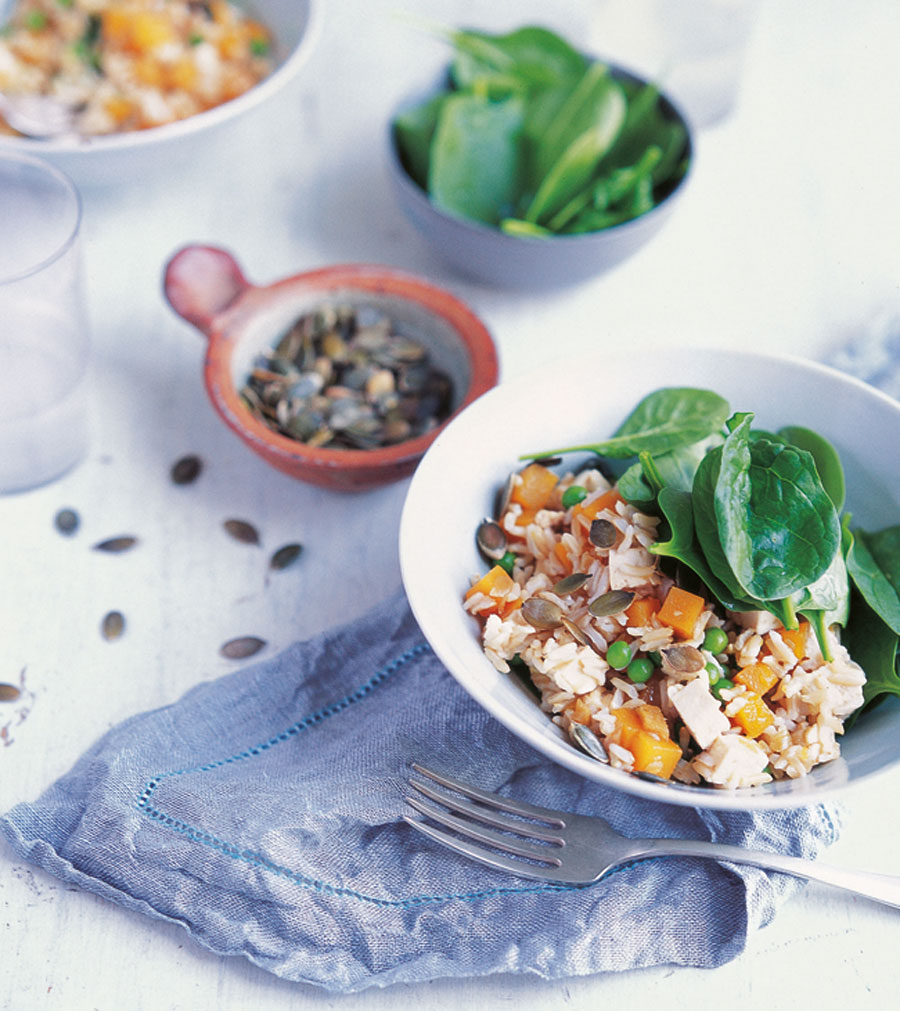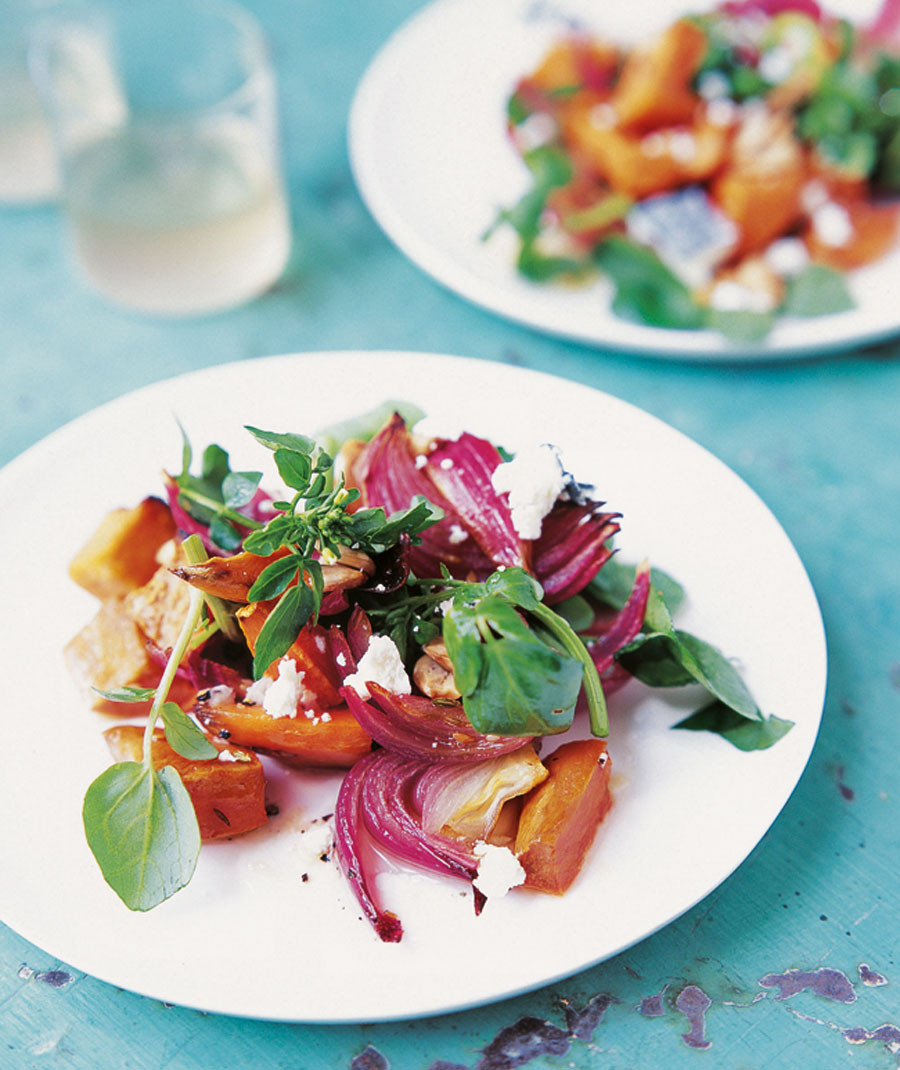In Eat Right for Your Body Type: The Super-Healthy Detox Diet Inspired by Ayurveda, chef Ajum Anand explains Ayurveda’s three body types (doshas) and their connection to food and health.
By using Anand’s questionnaire, you can identify which dosha — vata, pitta and kapha — dominate in your body and what foods suit that best.
The book includes 75 recipes in total and three detox options to help readers get in shape naturally and achieve better digestion, energy, and immunity.
To read our interview with chef Anjum Anand, click here.
Warm Sweet Potato, Arugula, and Goat Cheese Salad (pictured above)
VATA: Fantastic for vata
PITTA; Good for pitta
KAPHA: Eat only occasionally
Sweet potatoes are really good for us as they contain lots of antioxidants, vitamins, and other healing properties. This salad is very grounding and nourishing, it is fantastic for vata but also good for pitta and only slightly increases kapha energy but in a positive way. It is a delicious salad — the sweetness of the potato, the peppery spices, the slight bitterness of the leaves, the lemony dressing, and the crunch of the almonds work really well together. The watercress is great for cleansing pitta and a good pungent green for warming up kapha and vata. Even though this recipe forms a side salad, I often eat a larger portion as a light meal in the summer months.
Serves 2 as a small salad
1 medium orange-fleshed sweet potato, diced into 1-inch cubes
1 small red onion, sliced into thin wedges
2 teaspoons vegetable oil
1⁄2 teaspoon panch phoran seeds (also called Bengali 5-seed mix)
Salt and freshly ground black pepper
11⁄2 ounces small watercress leaves
1⁄8 cup whole almonds, blanched and lightly roasted and split through the middle
2 ounces soft goat cheese (omit this if you have a kapha imbalance)
Salt and freshly ground black pepper
Dressing:
13⁄4 tsp lemon juice
4 tsp vegetable oil
1⁄2 tsp garlic paste
Preheat the oven to 375ºF.
Place the potato and onion on a small baking sheet. Heat the oil in a small saucepan and add the seeds. When they have sizzled for 10 seconds over low heat, pour over the vegetables, season, and mix well. Place in the oven and roast for 45 to 50 minutes, or until soft.
Whisk together all the ingredients for the dressing and season with salt and lots of freshly ground black pepper.
When ready to serve, I pour the dressing straight on the baking sheet and toss well to coat, then throw in the leaves and almonds and continue to stir until all well amalgamated. Plate up and serve warm with the goat cheese crumbled on top.

Hearty Lentil & Herb Soup
VATA: Garnish with Parmesan
PITTA: Great for pitta
KAPHA: Great for kapha; can add chili and buckwheat pasta
One-pot meals that cook slowly, allowing all the ingredients to cook together at an easy pace, are the ultimate meals in Ayurveda. This dish is easy to eat and easy to digest. You can add a little pasta to the cooking soup for a more substantial meal (kapha can add buckwheat pasta) or serve with a roll of whole grain (spelt or rye) bread. Vata can finish the dish with a spoon of freshly grated Parmesan.
Serves 4
2 to 3 tablespoons olive oil (kapha 2 tablespoons, pitta 21⁄2 tablespoons, vata 3 tablespoons)
2 rosemary sprigs
2 thyme sprigs
1 medium onion, minced
1 carrot, chopped
1 celery stalk, chopped
1⁄2 leek, sliced
2 garlic cloves, crushed
1 dried red chile (kapha only)
23⁄4 cups vegetable stock
Generous 11⁄8 cups Puy lentils, washed
Salt and freshly ground black pepper
Small handful of parsley, minced
A squeeze of lemon (optional)
Heat the oil in a large nonstick saucepan.Add the rosemary, thyme, onion, carrot, celery, and leek and sweat, covered, over low heat for 6 to 7 minutes, or until the onions are soft.
Add the garlic, dried chile (if using), stock, and lentils, bring to a boil, then cover and simmer gently for 25 minutes, or until the lentils are cooked. Pour about one-third of the soup into a blender, puree to a paste, then stir back into the saucepan along with seasoning, parsley, and lemon juice (if using) to taste. Add extra warm water if you prefer a thinner consistency, then serve.

Winter Squash, Tofu and Tamari Rice
VATA: Great for vata
PITTA: Great for pitta
KAPHA: Eat in moderation
This is a rich rice and vegetable dish with some Japanese flavours. It is quite a nourishing dish and the Kabocha squash is delicious here, but can happily be substituted with butternut squash. This is a great dish for vata and pitta but a little heavy in terms of the sweet taste for kapha, but they can always serve small portions and supplement with vegetables. Vata can also serve smaller portions without the tofu and add some broiled salmon on the side.
Serves 2–3, or 4 as a side dish
Scant 1⁄2 cup white or brown rice (I use basmati, but any will do), washed
1 tablespoon vegetable oil
1 small onion, minced
2 teaspoons minced ginger
3 to 4 teaspoons tamari (wheat-free soy sauce) or dark soy sauce
1 tablespoon raw cane sugar
1 tablespoon Japanese mirin
9 ounces Kabocha squash or butternut squash, skin left on and cut into 1⁄2-inch cubes
2⁄3 cup water
31⁄2 ounces firm tofu, cut into 1⁄2-inch cubes, or a handful of cooked aduki beans
Generous 3⁄4 cup peas, shelled weight (or use frozen)
1 teaspoon black sesame seeds (vata) or 2 teaspoons pumpkin seeds (pitta), raw or lightly roasted
Cook and drain the rice according to package directions.
Heat the oil in a medium nonstick saucepan. Add the onion and cook until soft. Add the ginger, tamari, sugar, mirin, and let bubble for 1 minute, then add the squash with the water. Bring to a boil, cover, and simmer for 15 minutes, or until the squash is just soft. Add the tofu and peas after 5 minutes (if using frozen peas, add after 10 minutes).
When done, add the cooked rice and stir all together gently, cover and leave on very low heat for 4 to 5 minutes to allow the flavours to marry. Uncover and allow any excess water to cook off, leaving sweet, savoury, and slightly sticky rice.
Serve sprinkled with the sesame seeds (vata) or pumpkin seeds (pitta).
